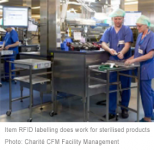
Charité Hospital in Berlin uses Xerafy medical tags to manage surgical instruments
[ad_1]
For Charité Hospital in Berlin, Germany, the time and cost of managing 300,000 surgical instruments has always been the work that the hospital needs to improve. Hospitals have adopted coding and laser marking methods, but the devices will still be mixed together because the codes engraved on the devices are not easy to read, and it is not convenient to record information about the full life cycle of the devices. In February of this year, Charité Hospital finally found a solution for them: using RFID technology-based surgical instrument tracking, this solution uses medical-grade RFID tags and installation methods provided by Xerafy, and a well-known German refined surgical instrument management solution The software system provided by the solution provider ASANUS.

The RFID im Blick Global website recently interviewed the person in charge of the surgical instrument disinfection management department about this project: The hospital released two different pilot projects, each using different software systems. The label is glued to the device through a special epoxy glue, and it is automatically tracked in all aspects of the device management process.
The hospital carried out a series of disinfection tests on the labeled devices, including chemical cleaning, pressure testing during transportation, and high-temperature disinfection. These tests ensure the durability and reading performance of the label on the device. The results show that Xerafy’s medical-grade label and label installation program can withstand at least 500 strict hospital disinfection and sterilization cycles.
Throughout the pilot program, the glue used to install the label is critical. Oasmancevic, the head of the hospital’s equipment management department, said in an interview: “Our first concern is whether the glue meets biocompatibility. Any glue that does not meet medical requirements will not be used.” This epoxy glue must secure the label. The ground is fixed on the device and cannot fall off. “We tested all the sterilization processes and found no problems. In actual operation, the device will come into contact with blood, physiological saline, iodine and other chemicals. We hope that these conditions will not affect the label. We will pay close attention to this point.”
Osmancevic also mentioned that the use of glue to install the label proved to have no effect on the use of the device itself, because the label did not change the physical structure of the device, and the hospital also worked closely with the device manufacturer to resolve more label installation questions. In general, the label does not affect the device itself, and doctors and nurses also said that they do not think the label will affect their use of the device.
The hospital stated that the solutions of the two suppliers were good, but the hospital finally chose ASANUS because they were already using the disinfection equipment management software provided by ASANUS, and the newly added RFID module did not need to add a new system. “RFID helps us achieve higher-quality process management in the disinfection process. In 2017, the newly-built equipment management department of the hospital will adopt RFID for management.” Osmancevic is very informative about the solution.
[ad_2]



